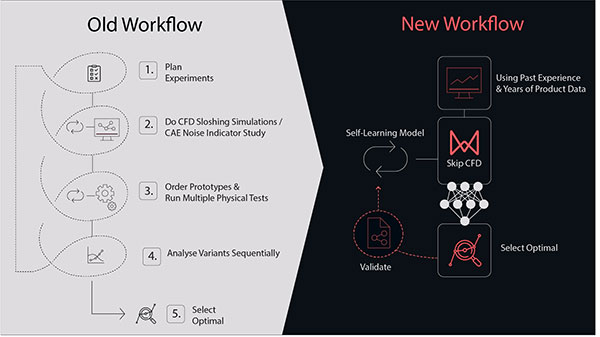
Fig. 1: Initially, too much effort and waiting times were spent on testing physical prototypes as well as performing numerically expensive computational fluid dynamics sloshing simulations. By training self-learning models based on historic test data, the team of engineers can now skip the physics-based CFD approach. Images courtesy of Kautex-Textron.
June 29, 2023
Artificial intelligence (AI) has the potential to enhance and improve numerous design and engineering workflows. In the automotive space, as companies struggle with design challenges presented by disruptive technologies like electrification and autonomy, AI-based solutions can help engineers improve and accelerate their work. This is particularly valuable given the pressure to innovate and iterate rapidly.
Kautex, a Textron Inc. company, is an automotive supplier for a number of global original equipment manufacturers. The company recently used an AI solution from Monolith to help its engineers reduce the noise of fuel sloshing in a tank, and the AI technology not only helped reduce the noise, but also reduced prototyping and testing costs.
We spoke to Dr. Bernhardt Lüddecke, global director of Validation, Kautex-Textron, and Dr. Joël Henry, principal engineer at Monolith, to learn more about the project.
Digital Engineering: Why is fuel sloshing such a challenging design issue? What sorts of factors affect the degree of noise, and why is this important?
Dr. Bernhardt Lüddecke: As we transition to hybrid-electric vehicles, you may well drive long distances electrically, which means you do not hear any ambient motor noise. In a traditional car, the engine masks the sloshing. So the more you get into hybrid vehicles where you still have fuel on board, the more important it is to reduce the sloshing noise. The fluid keeps moving when the car decelerates.
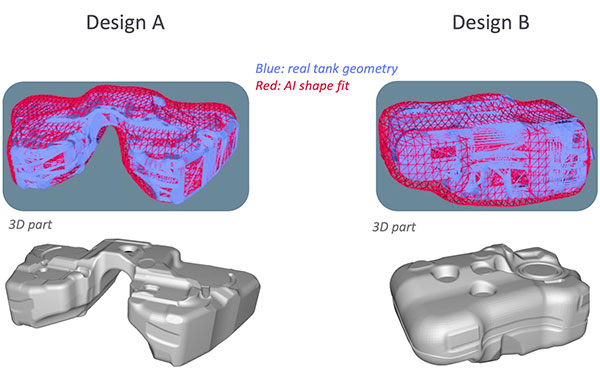
Usually you have slosh walls or slosh paths that can dampen the noise. There are two methods to test that. First, you can have a tank prototype, and have walls to break the fluid that is moving to dampen the motion, and you take a measurement, usually by mounting the tank on a sled and having it float down the sled. You can measure the amplitude of the noise and the full frequency of the noise.
The second procedure is to use a virtual object, where you try to simulate the same thing as a multiphysics problem. You simulate the sudden stop of a tank and simulate the motion of the air and fluid. This is impinging on the tank to cause deformation to its shape, and the shape acts like a loudspeaker and produces noise. The noise has to be simulated, and a virtual microphone records that noise.
The problem is that frequency resolution is hard to achieve because it is numerically very expensive.
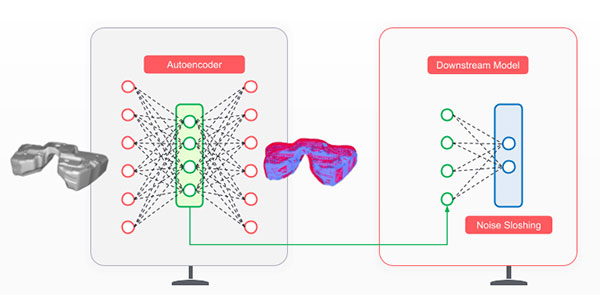
The question we had was, is it possible to get this multiphysics problem into machine learning to find correlations? Happily, the answer is yes. We can skip a lot of CAE [computer-aided engineering] activity by leveraging decades of experience of fuel knowledge and acoustic knowledge and data. We can go from big data and machine learning analysis to a result, and we proved this is possible for an unknown shape. It was a great achievement.
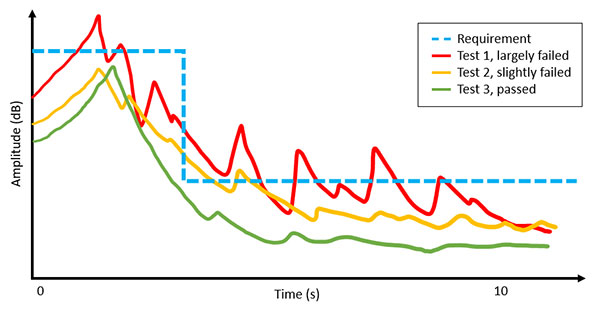
DE: How did you start working with Monolith?
Lüddecke: LinkedIn is a powerful network, and we had seen some articles about their work. We talked to other startups and it seemed Monolith was open enough to attempt to solve this challenge, to do a proof of concept and provide the right support.
DE: What types of design and simulation software do you use in your engineering organization? How does Monolith fit in?
Lüddecke: As a subsidiary of Textron, we have a powerful engineering organization. We are leveraging everything from Ansys Fluent, Altair, [and] CATIA, and we also have LS-Dyna from Ansys. We had previously tried to use machine learning for blow molding, but never in such a way that you could really enable the democratization of simulation. You need to have geeks to do that. Monolith can be deployed in a way that is democratizing.
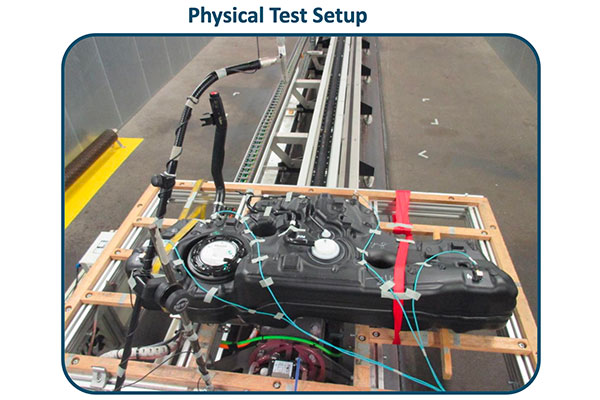
DE: Why was this fuel tank application a good fit for machine learning?
Lüddecke: We have tons of data because of our 50 years of heritage in fuel tanks. We have an elaborate fuel acoustic test bench, decades of data and it is high-resolution data. We chose this as proof of concept because we know so much. We were really challenging the tool.
We do not have so much data for batteries yet. We now have seen that this tool is so powerful we can generate enough data for sampling or CAE. We have enough trust to say we can introduce this to new areas of product data.
We are only using physical test data. The complex CAE simulation that we usually rely on is very expensive and even if you solve it, the results are not always so convincing. We wanted to tackle the most complex problem in engineering of fuel tanks, and see what AI could do for us.
Joël Henry: Machine learning can solve an intractable physics problem, when simulation is too expensive. Once Monolith was in place at Kautex-Textron, the proof of concept was established in 3 months or a little longer. That included all the onboarding and training.
DE: Were there any challenges in getting your team to buy into or trust using AI for these purposes?
Lüddecke: It still is a challenge. We were trying to introduce it this year, and still had to solve some license agreements, because we also have to guarantee whatever we do with our customer data.
Of course, there will be people who say, “What is this? I don’t believe this.”
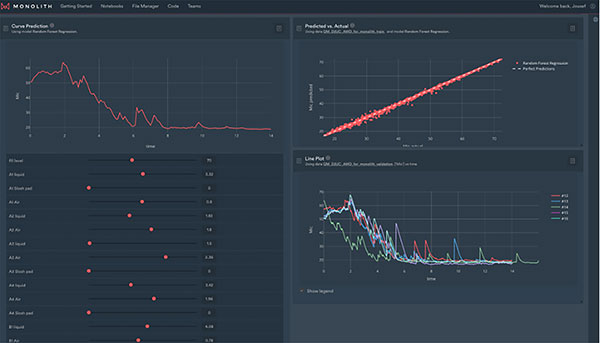
We have been using training data and validation data. With machine learning, everything not included in the training data is unknown. We have been doing multiple permutations on training.
It is still a challenge to see if it really works for a new problem that is unknown to us and to the AI.
Henry: You can validate machine learning, train it and then try it on something new. Then you gain confidence in the model. But it does not guarantee that it will work with certification. That is easier with testing or simulation tools, because the certification will look at the method that is used. For AI it is much harder. We are looking into this, but it is difficult at the moment. You rely on validation. You cannot use AI for certification right now, but you can bypass a lot of iterations in the design process with AI.
DE: How do you incorporate these results into new designs?
Lüddecke: The way we want to deploy this is that the CAE group can develop these tools with Monolith. It has an easy-to-use graphical user interface, and the deployment is not to the CAE analysts but to the designers. Instead of doing best-guess iterations and then giving that design to the CAE group and getting it back over and over again, we can now say we trust the AI. The designer is uploading a new design to the cloud, receiving results and then iterating on that. We are frontloading that activity, which relieves the CAE department so they can improve the products and enrich the job of the design engineer.
DE: What are the next steps?
Lüddecke: I would say two things. Let’s stay at fuel. We see in western Europe and other countries, we are quoting for it. We want to deploy it this year with more design features than the proof of concept, which included tank shape and fill level. We have to add baffles that break the sloshing noise, and add dampening devices that we call slosh paths, and some other interior components that require good geometry resolution that Monolith just provided to us.
Everything else will be on our Pentatonic battery products. We are looking at the battery enclosure, modeling of the compression molding, warpage, post-curing [and] how the complete housing looks after it has been cured. It is a very complex product and production process.
We are looking at crash or crush procedures as well, where we take the battery housing and make sure that whatever happens to the motion of the vehicle or at impact, that the cells are safe, and that we can predict deformation of the housing, respecting fiber orientation. It is a complex problem, and the next huge challenge that we will present to that tool.
More Monolith Coverage
Subscribe to our FREE magazine, FREE email newsletters or both!
About the Author
Brian Albright is the editorial director of Digital Engineering. Contact him at [email protected].
Follow DE





